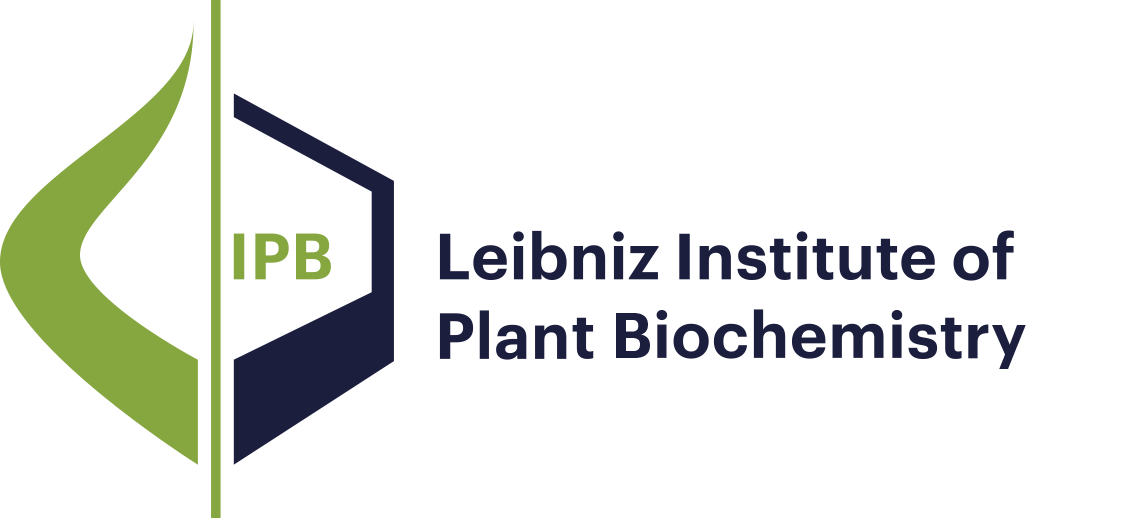- Results as:
- Print view
- Endnote (RIS)
- BibTeX
- Table: CSV | HTML
Publications
Publications
Research Mission and Profile
Molecular Signal Processing
Bioorganic Chemistry
Biochemistry of Plant Interactions
Cell and Metabolic Biology
Independent Junior Research Groups
Program Center MetaCom
Publications
Good Scientific Practice
Research Funding
Networks and Collaborative Projects
Symposia and Colloquia
Alumni Research Groups
Publications
Isoprenoid biosynthesis in plant plastids occurs via the 1-deoxy-d-xylulose 5-phosphate (DXP) pathway. We used tobacco rattle virus (TRV) to posttranscriptionally silence the expression of the last two enzymes of this pathway, the IspG-encoded (E)-4-hydroxy-3-methylbut-2-enyl diphosphate synthase (HDS) and the IspH-encoded isopentenyl/dimethylallyl diphosphate synthase (IDDS), as well as isopentenyl/dimethylallyl diphosphate isomerase (IDI), the enzyme that interconverts IPP and DMAPP. TRV-IspG and TRV-IspH infected Nicotiana benthamiana plants had albino leaves that contained less than 4% of the chlorophyll and carotenoid pigments of control leaves. We applied [13C]DXP and [14C]DXP to silenced leaves and found that 2-C-methyl-d-erythritol 2,4-cyclodiphosphate accumulated in plants blocked at HDS while DXP, (E)-4-hydroxy-3-methylbut-2-enyl phosphate and (E)-2-methylbut-2-ene-1,4-diol accumulated in IDDS-blocked plants. Albino leaves from IspG- and IspH-silenced plants displayed a disorganized palisade mesophyll, reduced cuticle, fewer plastids, and disrupted thylakoid membranes. These findings demonstrate the participation of HDS and IDDS in the DXP pathway in plants, and support the view that plastid isoprenoid biosynthesis is metabolically and physically segregated from the mevalonate pathway. IDI-silenced plants had mottled white-pale green leaves with disrupted tissue and plastid structure, and showed an 80% reduction in pigments compared to controls. IPP pyrophosphatase activity was higher in chloroplasts isolated from IDI-silenced plants than in control plant chloroplasts. We suggest that a low level of isoprenoid biosynthesis via the DXP pathway can occur without IDI but that this enzyme is required for full function of the DXP pathway.
Publications
Experimental and theoretical investigations concerning the second‐to‐last step of the DXP/MEP pathway in isoprenoid biosynthesis in plants are reported. The proposed intrinsic or late intermediates 4‐oxo‐DMAPP ( 12 ) and 4‐hydroxy‐DMAPP ( 11 ) were synthesized in deuterium‐ or tritium‐labeled form according to new protocols especially adapted to work without protection of the diphosphate moiety. When the labeled compounds MEcPP ( 7 ), 11 , and 12 were applied to chromoplast cultures, aldehyde 12 was not incorporated. This finding is in agreement with a mechanistic and structural model of the responsible enzyme family: a three‐dimensional model of the fragment L271–A375 of the enzyme GcpE of Streptomyces coelicolor including NADPH, the Fe 4 S 4 cluster, and MEcPP ( 7 ) as ligand has been developed based on homology modeling techniques. The model has been accepted by the Protein Data Bank (entry code 1OX2). Supported by this model, semiempirical PM3 calculations were performed to analyze the likely catalysis mechanism of the reductive ring opening of MEcPP ( 7 ), hydroxyl abstraction, and formation of HMBPP ( 8 ). The mechanism is characterized by a proton transfer (presumably from a conserved arginine 286) to the substrate, accompanied by a ring opening without high energy barriers, followed by the transfer of two electrons delivered from the Fe 4 S 4 cluster, and finally proton transfer from a carboxylic acid side chain to the hydroxyl group to be removed from the ligand as water. The proposed mechanism is in agreement with all known experimental findings and the arrangement of the ligand within the enzyme. Thus, a very likely mechanism for the second to last step of the DXP/MEP pathway in isoprenoid biosynthesis in plants is presented. A principally similar mechanism is also expected for the reductive dehydroxylation of HMBPP ( 8 ) to IPP ( 9 ) and DMAPP ( 10 ) in the last step.

